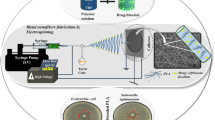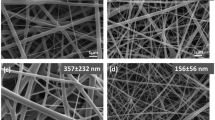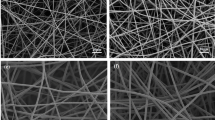Abstract
Biocompatible nanofibers that are capable of adapting to the physiological conditions of the human body have become increasingly important for clinical applications in recent years. Electrospun fiber mats offer particular advantages due to their large surface area and their sorption/release properties. If loaded with drugs, delivery properties can be tailored to a specific release rate. This research work focuses on poly(L-lactic acid) (PLA) and poly(ε-caprolactone) (PCL) incorporating three different model antibiotics as well as bicomponent fibers made from PLA and PCL containing the same model drugs. Tetracycline and chlorotetracycline hydrochloride, and amphotericin B were selected as model drugs and their release properties and antimicrobial effectiveness studied. The surface morphology and the average diameter of the fibers strongly depended on the individual spinning system which in turn influenced the release of the therapeutic compounds from the fibers. Tetracycline was discharged from PCL at the highest rate while amphotericin B was slowest. PCL almost completely liberated any of the drugs over time while PLA only released about 10% total. By forming bicomponent PCL–PLA fibers surface and release characteristics could be modified to fit a sensible drug delivery.









Similar content being viewed by others
References
Bognitzki M, Czado W, Frese T, Schaper A, Hellwig M, Steinhardt M, Greiner A, Wendorff JH (2001) Nanostructured fibers via electrospinning. Adv Mater 13(1):70–72
Boland ED, Wnek GE, Simpson DG, Pawlowski KJ, Bowlin GL (2001) Tailoring tissue engineering scaffolds by employing electrostatic processing techniques: a study of poly(glycolic acid). J Macromol Sci 38:1231–1243
Buschle-Diller G, Erdonmez F (2003) Electrospinning of nanofibers from biodegradable polymers, Intern. Proceedings of Nonwovens Techn. Conf., Baltimore
Buschle-Diller G, Cooper J, Richardson T, Hawkins A (2005) Electrospun nanofibers from renewable resources. 229th ACS National Meeting, San Diego
Buschle-Diller G, Hawkins A, Cooper J (2006) Electrospun nanofibers from biopolymers and their biomedical applications. In: Edwards V, Buschle-Diller G, Goheen S (eds) Fiber modifications for specialty and medical applications. Springer, London, pp 67–80
Chu CC, von Fraunhofer JA, Greisler HP (1997) Wound closure materials and devices. CRC Press LLC, Boca Raton
Chung HY, Hall JRB, Gogins MA, Crofoot DG, Weik TM (2002) Polymer, polymer microfiber, polymer nanofiber and applications including filter structures PCT Int. Appl. WO 2001-US24948 20010809
Deitzel JM, Kleinmeyer J, Hirvonen JK, Beck TNC (2001) Controlled deposition of electrospun poly(ethylene oxide) fibers. Polymer 42:8163–8170
Doshi J, Reneker DH (1995) Electrospinning process and applications of electrospun fibers. J Electrostatics 35(2/3):151–160
Fong H, Chun I, Reneker DH (1999) Beaded nanofibers formed during electrospinning. Polymer 40:4585–4592
Gibson P (2003) Production and characterization of patterned electrospun fibrous membranes. Proceedings of Fiber Soc. Meeting, pp 42–49
Gibson P, Schroeder-Gibson H, Rivin D (2001) Transport properties of porous membranes on electrospun nanofibers. Colloids Surf A Physicochem Eng Asp 187–188:469–681
Gupta P, Wilkes GL (2003) Some investigations on the fiber formation by utilizing a side-by-side bicomponent electrospinning approach. Polymer 44:6353–6359
Hawkins A, Buschle-Diller G (2004) Characterization of polymer solutions intended for electrospinning. Fiber Society Fall Meeting, Ithaca
Hawkins A, Wood J, Buschle-Diller G (2004) Advances in electrospinning of biopolymers, AATCC Intern. Convention & Exhibition, Greenville
Huang ZM, Zhang YZ, Kotaki M, Ramakrishna S (2003) A review on polymer nanofibers by electrospinning and their applications in nanocomposites. Composites Sci Technol 63(15):2223–2253
Jiang H, Hu Y, Li Y, Zhao P, Zhu K, Chen W (2005) A facile technique to prepare biodegradable coaxial electrospun nanofibers for controlled release of bioactive agents. J Control Release 108:237–243
Kahol PK, Pinto NJ (2004) An EPR investigation of electrospun polyaniline-polyethylene oxide blends. Synth Met 140:269–272
Kenawy E-R, Abdel-Hay FI, El-Newehy MH, Wnek GE (2007) Controlled release of ketoprofen from electrospun poly(vinyl alcohol) nanofibers. Mat Sci Eng A 459:390–396
Kewany ER, Bowlin GL, Mansfield K, Layman J, Simpson DG, Sanders EH, Wnek GE (2002) Release of tetracycline hydrochloride from electrospun poly(ethylene-co-vinyl acetate), poly(lactic acid) and a blend. J Control Release 81(1–2):57–64
Kidoaki S, Kwon IK, Mattsuda T (2004) Mesoscopic spatial design of nano- and microfiber meshes for tissue-engineering matrix and scaffold based on newly devised multilayering and mixing electrospinning techniques. Biomaterials 26:37–46
Kim K, Luu YK, Chang C, Fang D, Hsiao BS, Chu B, Hadjiargyrou M (2004) Incorporation and controlled release of a hydrophilic antibiotic using poly(lactide-co-glycolide)-based electrospun nanofibrous scaffolds. J Control Release 98(1):47–56
Kit K, Jagannathan S (2002) Electrospinning of nylons, poly(ethylene terephthalate) and their blends. Fiber Society Fall Technical Meeting, Book of Abstracts, 25
Lee SH, Yoon JW, Moon H (2002) Continuous nanofibers manufactured by electrospinning technique. Macromol Res 10(5):282–285
Li L, Hsieh YL (2005) Ultra-fine polyelectrolyte fibers from electrospinning of poly(acrylic acid). Polymer 46:5133–5139
Luong-Van E, Grøndahl L, Chua KN, Leong KW, Nurcombe V, Cool SM (2006) Controlled release of heparin from poly(ε-caprolactone) electrospun fibers. Biomaterials 27:2042–2050
Luu YK, Kim K, Hsioa BS, Chu B, Hadjiargyrou M (2003) Development of a nanostructured DNA delivery scaffold via electrospinning of PLGA and PLA-PEG block copolymers. J Control Release 89(2):341–353
Reneker DH, Chun I (1996) Nanometer diameter fibres of polymer, produced by electrospinning. Nanotechnol 7(3):216–223
Simpson DG, Bowlin GL, Wnek GE, Stevens PJ, Carr ME, Matthews JA, Rajendran S (2004) Electroprocessed collagen and tissue engineering. US Patent application 0040037813
Shin YM, Hohman MM, Brenner MP, Rutledge GC (2001) Experimental characterization of electrospinning: the electrically forced jet and instabilities. Polymer 42(25):9955–9967
Smith LA, Ma PX (2004) Nano-fibrous scaffolds for tissue engineering. Colloids Surf B Biointerf 39(3):125–131
Spasova M, Manolova N, Paneva D, Rashkov I (2004) Preparation of chitosan-containing nanofibers by electrospinning of chitosan/poly(ethylene oxide) blend solutions. e-Polymers, no. 056
Taepaiboon P, Rungsardthong U, Supaphol P (2006) Drug-loaded electrospun mats of poly(vinyl alcohol) fibres and their release characteristics of four model drugs. Nanotechnology 17:2317–2329
Taepaiboon P, Rungsardthong U, Supaphol P (2007) Vitamin-loaded electrospun cellulose acetate nanofiber mats as transdermal and dermal therapeutic agents of vitamin A acid and vitamin E. Eur J Pharma Biopharma 67:387–397
Theron SA, Zussman E, Yarin AL (2004) Experimental investigation of the governing parameters in the electrospinning of polymer solutions. Polymer 45:2017–2030
Tungprapa S, Jangchud I, Supaphol P (2007) Release characteristics of four model drugs from drug-loaded electrospun cellulose acetate fiber mats. Polymer 48:5030–5041
Yoshimoto H, Shin YM, Terai H, Vacanti JP (2003) A biodegradable nanofiber scaffold by electrospinning and its potential for bone tissue engineering. Biomaterials 24:2077–2082
Zeng J, Yang L, Liang Q, Zhang X, Guan H, Xu X, Chen X, Jing X (2005) Influence of the drug release compatibility with polymer solution on the release kinetics of electrospun fiber formation. J Control Release 105(1–2):43–51
Zong X, Kim K, Fang D, Ran S, Hsaio BS, Chu B (2002) Structure and process relationship of electrospun bioabsorbable nanofiber membranes. Polymer 43(16):4403–4412
Acknowledgment
The authors would like to thank Dr. Huang, Nutrition and Food Science Department, Auburn University, for assistance with the antimicrobial testing.
Author information
Authors and Affiliations
Corresponding author
Rights and permissions
About this article
Cite this article
Buschle-Diller, G., Cooper, J., Xie, Z. et al. Release of antibiotics from electrospun bicomponent fibers. Cellulose 14, 553–562 (2007). https://doi.org/10.1007/s10570-007-9183-3
Received:
Accepted:
Published:
Issue Date:
DOI: https://doi.org/10.1007/s10570-007-9183-3




